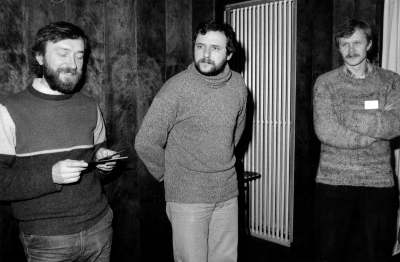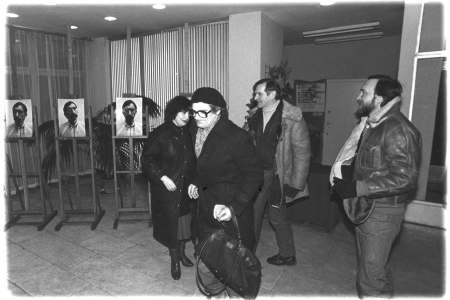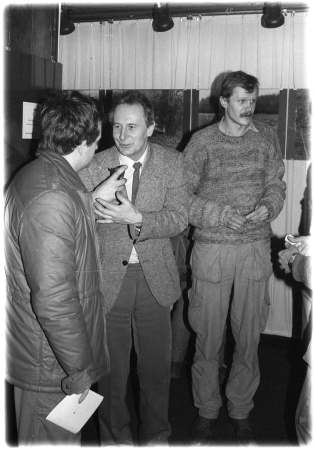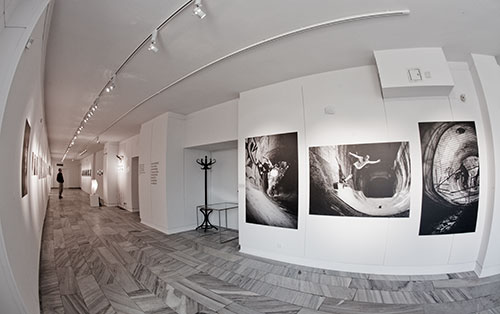The FF Gallery (FF stands in Polish for "Forum Fotografii",
i. e. "Forum of Photography") came into being due to the efforts
of the writer of this text in December, 1983, at the Łódź-Widzew
District House of Culture (Dzielnicowy Dom Kultury Łódź-Widzew),
where it had functioned until June, 1989.
In December of 1989 the Gallery started functioning again
under the supervision of the Łódź House of Culture (Łódzki Dom
Kultury). It is now conveniently situated and its exhibitive and
organizational conditions have improved significantly since then.
The programme of the Gallery is dependent on the current
cultural situation and the condition of our artistic circles.
Stormy political changes of the 1980s which took place in Poland
most clearly pointed to the crisis of the modernist formation,
the crisis that had been visible much earlier in culture as a whole and in art especially. The accompanying breakdown of the
avant-garde hierarchy of values as well as of creative strategies
connected with them, gave rise to extreme variations within the
group of individuals who continued their artistic searches. Some
of these efforts may be called postmodernist, depending on how
broadly the term is used. Others, difficult to define today, show
that they are "conscious of the times" and that after the process
of shaping a new cultural formation will have come to an end they
may find their own place in art history and receive recognition.
As far as this problem is concerned the FF Gallery has taken
up the task of broad and varied presentation of those
contemporary branches of art which employ (or incorporate) the
photographic medium. The method of work adopted by the Gallery
commits it to the organization of exhibitions authorial,
monothematic or showing the evolution of a creative, individual
approach to art - it strives to present contemporary photography
as a fertile and important element of culture, which describes
and shapes it at the same time.
The Gallery has organised about a hundred and fifty
exhibitions up till now, presenting most of the most significant
tendencies in Polish photography and some of its most eminent
representatives. In the first period of the Gallery's existence a critical approach to the political and social situation in the
country became most visible. This topic was raised by the
exbibitions of Zdzisław Pacholski, Anna Bohdziewicz, Bogdan
Sarwiński and Zbigniew Sejwa. Later, as the political situation
stabilized, the foreground of the programme of the Gallery became
occupied by intermediary tendencies and a postmodernist climate.
In this context one should mention Leszek Golec, Andrzej
Janaszewski or Włodek Krzemiński as characteristic for the period
in question - but many other artists have referred to this
climate as a significant element which gives character to artistic expression.
The Gallery also presented the classics of Polish
photography, active in the 80s: Zofia Rydet, Jerzy Lewczyński,
Stefan Wojnecki and Józef Robakowski.
An important trend for modern culture, the trend of the
return to "sacrum" and to metaphysical inquiries was exemplified
by the exhibitions of Andrzej Różycki, Andrzej Brzeziński and
Tomasz Sobecki. Grzegorz Przyborek's, Stefan Wojnecki's, Zbigniew
Tomaszczuk's and Witold Węgrzyn's exhibitions were, on the other
hand, examples of the fashionable and currently practised trend
of staged photography.
The Gallery also presented the work of typical
individualists, difficult to ascribe to the above-mentioned
tendencies, like Wiesław Brzóska, Wojciech Niedzielko,
Piotr Tomczyk, Bolesław Stachowa or Wiesław Barszczak...
What one ought to stress within the form which the programme
of the Gallery has taken is the tendency to favour media art -
works that combine photography with other kinds of art and make
them into a coherent whole - which allows us to see photography
as a branch of contemporary plastic arts, or (in a broader sense)
as a branch of contemporary art, not as an isolated profession,
locked away in a ghetto. Such works were exhibited at the Gallery
by various well-known artists: Marcin Berdyszak, Jerzy
Grzegorski, Wiesław Brzóska, and recently Edward Łazikowski and
Zbigniew Treppa.
The youngest generation of Polish photographers was given an
opportunity to present their achievements at a number of
individual exhibitions at the Gallery. To name but a few most
interesting artists among them we should mention: Sławomir
Barcik, Irena Nawrot, Konrad Kuzyszyn, Danuta Kuciak, Rafał
Magierski, Tomasz Michałowski, and most recently, Sławomir Kubala
and Elżbieta Janicka.
A big group exhibition called The Changing of the Guards,
organized in 1991 with the help of Krzysztof Jurecki, was devoted
to the problems of young photography - it was an exhibition which
tried to analyze stylistical changes in Polish photography,
introduced by the youngest (at that time) generation of artists
who made use of photography in their works.
An imposing event that took place at the Gallery was also an
exhibition entitled CONSTELLATION, organized to celebrate the
tenth anniversary of the founding of the Gallery. In spite of the
fact that the occasion was "historical", the exhibition did not
have a strictly historical character. Since the main goal of the
Gallery is to follow all the latest artistic tendencies, I decided to construe the anniversary exhibition along these lines
as well.
Returning to those authors who had presented their
individual exhibitions at the FF Gallery, I selected those
artists whose work seemed to me to be most significant in the
picture of contemporary Polish photography, linked with
multimedia or inter-media art. And so the exhibition was made up
of works by 29 authors - the classics of photography, still
active in the field, like Zofia Rydet, Stefan Wojnecki and Józef
Robakowski, artists belonging to the middle-aged generation and
finally the youngest, but already mature photographers, active in
places like Łódź, Poznań or Lublin.
Thus the exhibition, without exhausting the subject, showed
a great many of contemporary artworks by Polish artists who make
use of photography.
The premiere of the exhibition took place in December, 1993
at the Łódź House of Culture, and in April of 1994 it was shown
at the Polish Culture Institute in Berlin. Favourable opinions of
artists and critics made the Ministry of Culture and Art include
"CONSTELLATION" in the festivities of the Polish Days in Bavaria
in 1995. Raising the exhibition to the high rank of the event and
trying to match the exhibition space (550 square metres) I added
many works to it and broadened it greatly. Called CONSTELLATION
2 it was shown at the Maximillian University in Munich and at
the Gallery of the Townhouse in Landshut - in October of 1995. In
this form the exhibition became the largest ever presentation of
Polish artistic photography in Germany.
To mark its fifteenth anniversary, in December of 1998, the
Gallery prepared a nationwide, complex exhibition of Polish
photography, entitled Photography and Space. On the basis of
fifteen works of most prominent Polish artists, who use the
medium of photography, the exhibition analyzed the problem of
mutual relations between space and photography (a rudimentary
problem on a worldwide scale). A co-commissioner of this
exhibition was Lech Lechowicz, also the author of an essay,
published in the exhibition catalogue and written in the form of
an introduction to the problem suggested by the title (like in
most previous cases, a carefully edited catalogue accompanied
this exhibition, too). After its premiere at the Łódź House of
Culture the "Photography and Space" exhibition was presented next
year at the BWA (Bureau of Artistic Exhibitions) in Jelenia Góra
and at the Empty Gallery of the Cultural Centre of Górny Śląsk.
In 2003 celebrating its 20th anniversary the FF Gallery presented an exhibition called Łódź of Photography and a catalogue published in three languages. The exposition was shown in Poland (at the FF Gallery and Amcor Rentsch Gallery) and in France (Polish Institute in Paris). The curators of the project, Krzysztof Cichosz and Lech Lechowicz, focused on artists from Łódź and its artistic environment. The unique position of the city of Łódź on the artistic map of Poland was critically analyzed in the accompanying catalogue by Lech Lechowicz. Łódź of Photography also became an excuse for the analysis of the history of photographic exhibitions in Łódź since their beginning, dated around the second half of the 19th century. Grzegorz Bojanowski took this responsibility in his article called Exhibitions of Photography - Photography at Exhibitions. A Historical Essay on Photographic Exhibitions in Łódź.
Our exhibition demonstrated various attitudes and styles of leading artists of creative photography who are connected in some way with Łódź, although not all of them necessarily live here, like Witold Krymarys, Andrzej Różycki, Zygmunt Rytka, Konrad Kuzyszyn, Józef Robakowski, Krzysztof Cichosz, Barbara Konopka, Edward Łazikowski.
In 2002 with the collaboration of the British Council the FF Gallery organized an exposition of ground-breaking colour photographs by Madame Yevinde entitled Be Original or Die. In the same year the Gallery also prepared an important exhibition which was a summing up of the 1990s called Around a Decade. Polish Photography of the 1990s. The curators were Krzysztof Cichosz, Adam Sobota and Krzysztof Jurecki, and among the participants we should mention Leszek Golec, Tatiana Czekalska, Waldemar Jama, Tomasz Kizny, Zofia Kulik, Tomasz Komorowski, Bogdan Konopka, Sławomir Kubala, Konrad Kuzyszyn, Andrzej Lachowicz, Andrzej Jerzy Lech, Janusz Leśniak, Edward Łazikowski, Łódź Kaliska, Antoni Mikołajczyk, Natalia LL, Irena Nawrot.
To celebrate the 25th anniversary of the Gallery we published an album called The Time of Forum of Photography. This book contains extensive material illustrating a quarter of the century of the gallery's activity and was edited by Krzysztof Cichosz and Magdalena Świątczak - who in 2008 became the manager of the FF Gallery.
On FF Gallery

February 1984 - opening of exhibition.
From left: W.Krymarys, A.J.Lech, K.Cichosz
From left: W.Krymarys, A.J.Lech, K.Cichosz

January 1987 - exhibition of Leszek Golc.

March 1987 - exhibition of Stefan Wojnecki (in the centre).

FF Gallery, view of space.

FF Gallery, view of space.

FF Gallery, view of space.

FF Gallery, view of space.
Copyright ©2010
Galeria FF ŁDK